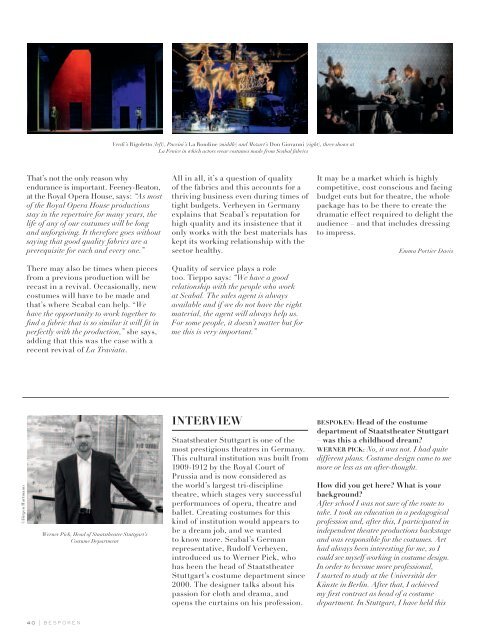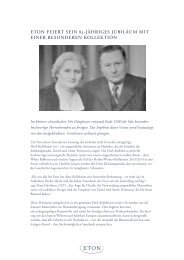Formal wear origins
Formal wear origins
Formal wear origins
Create successful ePaper yourself
Turn your PDF publications into a flip-book with our unique Google optimized e-Paper software.
©Jürgen Hartmann<br />
That’s not the only reason why<br />
endurance is important. Feeney-Beaton,<br />
at the Royal Opera House, says: “As most<br />
of the Royal Opera House productions<br />
stay in the repertoire for many years, the<br />
life of any of our costumes will be long<br />
and unforgiving. It therefore goes without<br />
saying that good quality fabrics are a<br />
prerequisite for each and every one.”<br />
There may also be times when pieces<br />
from a previous production will be<br />
recast in a revival. Occasionally, new<br />
costumes will have to be made and<br />
that’s where Scabal can help. “We<br />
have the opportunity to work together to<br />
find a fabric that is so similar it will fit in<br />
perfectly with the production,” she says,<br />
adding that this was the case with a<br />
recent revival of La Traviata.<br />
Werner Pick, Head of Staatstheater Stuttgart’s<br />
Costume Department<br />
Verdi’s Rigoletto (left), Puccini’s La Rondine (middle) and Mozart’s Don Giovanni (right), three shows at<br />
La Fenice in which actors <strong>wear</strong> costumes made from Scabal fabrics<br />
All in all, it’s a question of quality<br />
of the fabrics and this accounts for a<br />
thriving business even during times of<br />
tight budgets. Verheyen in Germany<br />
explains that Scabal’s reputation for<br />
high quality and its insistence that it<br />
only works with the best materials has<br />
kept its working relationship with the<br />
sector healthy.<br />
Quality of service plays a role<br />
too. Tieppo says: “We have a good<br />
relationship with the people who work<br />
at Scabal. The sales agent is always<br />
available and if we do not have the right<br />
material, the agent will always help us.<br />
For some people, it doesn’t matter but for<br />
me this is very important.”<br />
INTERVIEW<br />
Staatstheater Stuttgart is one of the<br />
most prestigious theatres in Germany.<br />
This cultural institution was built from<br />
1909-1912 by the Royal Court of<br />
Prussia and is now considered as<br />
the world’s largest tri-discipline<br />
theatre, which stages very successful<br />
performances of opera, theatre and<br />
ballet. Creating costumes for this<br />
kind of institution would appears to<br />
be a dream job, and we wanted<br />
to know more. Scabal’s German<br />
representative, Rudolf Verheyen,<br />
introduced us to Werner Pick, who<br />
has been the head of Staatstheater<br />
Stuttgart’s costume department since<br />
2000. The designer talks about his<br />
passion for cloth and drama, and<br />
opens the curtains on his profession.<br />
It may be a market which is highly<br />
competitive, cost conscious and facing<br />
budget cuts but for theatre, the whole<br />
package has to be there to create the<br />
dramatic effect required to delight the<br />
audience – and that includes dressing<br />
to impress.<br />
Emma Portier Davis<br />
BESPOKEN: Head of the costume<br />
department of Staatstheater Stuttgart<br />
– was this a childhood dream?<br />
WERNER PICK: No, it was not. I had quite<br />
different plans. Costume design came to me<br />
more or less as an after-thought.<br />
How did you get here? What is your<br />
background?<br />
After school I was not sure of the route to<br />
take. I took an education in a pedagogical<br />
profession and, after this, I participated in<br />
independent theatre productions backstage<br />
and was responsible for the costumes. Art<br />
had always been interesting for me, so I<br />
could see myself working in costume design.<br />
In order to become more professional,<br />
I started to study at the Universität der<br />
Künste in Berlin. After that, I achieved<br />
my first contract as head of a costume<br />
department. In Stuttgart, I have held this<br />
position now for eleven years. I like leading<br />
people on the one hand, and I love theatre<br />
and costumes, so this position is ideal.<br />
How many costumes are made each<br />
year in your workshops?<br />
We do not manufacture all our costumes;<br />
sometimes they are bought, some are<br />
second hand or we reuse older costumes.<br />
In our workshops, we produce around<br />
5,000 costumes per year. Beyond that, we<br />
produce shoes, hats, jewellery, weapons,<br />
armour and we are responsible for makeup<br />
and wigs.<br />
How many metres of fabric do<br />
you need, on average, to create a<br />
costume?<br />
That depends on the costume, starting<br />
from 50cm for a vest or accessory. Huge,<br />
historical costumes can need anything<br />
from 20 up to 30 metres. For a tutu, we<br />
need many metres of tulle, for example.<br />
How many people work in your<br />
department?<br />
It’s like a company within the company –<br />
our staff comprises around 200 people in<br />
15 sub departments, with an additional 20<br />
trainees in five different professions.<br />
Where do you find your inspiration?<br />
Art itself provides the inspiration, and<br />
the variety of tasks that demand different<br />
perspectives for opera, drama and dance.<br />
Maybe it is the most beautiful professional<br />
work, when you can always co-operate with<br />
artists. Personally, I draw energy from<br />
nature, visual arts and music.<br />
How and when did you first encounter<br />
Scabal?<br />
I have been working with Scabal for a<br />
long time, but I only visited the company<br />
for the first time in Brussels in 2009. I was<br />
fascinated by the combination of steady<br />
innovation with the knowledge of tradition.<br />
Scabal embodies both in perfect harmony!<br />
What kind of Scabal fabrics do you<br />
prefer?<br />
As to the colour – classic black, as to<br />
the material – smooth, comfortable and<br />
cuddly. Scabal Velvet fabric meets all my<br />
requirements!<br />
‘OUR STAFF COMPRISES AROUND 200<br />
PEOPLE IN 15 SUB DEPARTMENTS AND WE<br />
PRODUCE 5,000 COSTUMES PER YEAR.’<br />
Staatstheater Stuttgart<br />
Off-stage, what is your daily sartorial<br />
style?<br />
This can be very variable and I do<br />
not make a huge difference between<br />
professional and private life. As I am<br />
working in an artistic environment I can be<br />
casual in my own style. I like comfortable<br />
knitted jackets, as to the pants it can be<br />
jeans or something more extravagant.<br />
Lately, I have rediscovered traditional<br />
garbs as an inspiration. I like to renew<br />
combinations every day.<br />
What will be your fashion touch for<br />
next winter?<br />
Especially in winter, I have to care for<br />
multiple layers as I stay in different rooms<br />
with different temperatures at work and I<br />
normally come to work by bicycle! I will try<br />
out knitted layers, but never without sack<br />
coat or other jackets. My basic colour is<br />
black and I shall not change it, but mix into<br />
it gray, green or rust.<br />
Interview by Jérôme Stéfanski<br />
40 I BESPOKEN BESPOKEN I 41<br />
© Martin Sigmund © Martin Sigmund



